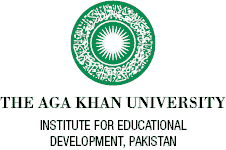Partnering with Parents: Education in rural areas during COVID-19
How did a School Head teacher partner with parents in the teaching and learning process during Covid-19 in rural areas of Sindh?
“Education in developing countries with patchy Internet coverage is particularly hard-hit by the COVID-19 pandemic” (Khan, 2020)
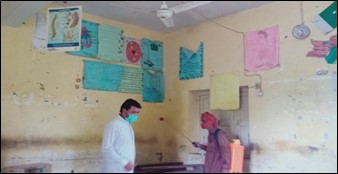 When the governments closed schools due to the pandemic, shifting to online classes was the only solution (Dawn, 2020). The Government of Pakistan took several initiatives to support education during COVID like tele-school, radio-school and AKES,P schools shared lessons through USBs (Universal Serial Bus). Teachers shared learning material with parents with the help of USBs. Parents then put it into their TV/LED/Receiver to run it so that their children were able to take lessons from home. The government of Sindh began reopening of schools by implementing Standard Operating Procedure (SOPs) from September 28, 2020 throughout the province.
When the governments closed schools due to the pandemic, shifting to online classes was the only solution (Dawn, 2020). The Government of Pakistan took several initiatives to support education during COVID like tele-school, radio-school and AKES,P schools shared lessons through USBs (Universal Serial Bus). Teachers shared learning material with parents with the help of USBs. Parents then put it into their TV/LED/Receiver to run it so that their children were able to take lessons from home. The government of Sindh began reopening of schools by implementing Standard Operating Procedure (SOPs) from September 28, 2020 throughout the province.
Re-opening of the Schools and Related Dilemmas
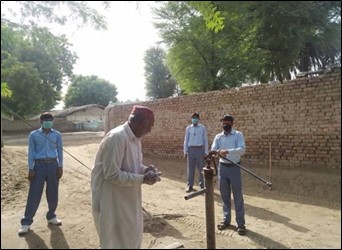 The schools reopened with the instructions of following SOPs such as washing hands with soap, wearing a mask, maintaining six feet distance and avoiding touching one’s face while coughing or sneezing.
The schools reopened with the instructions of following SOPs such as washing hands with soap, wearing a mask, maintaining six feet distance and avoiding touching one’s face while coughing or sneezing.
Following SOPs was a challenge for rural public schools which lacked basic facilities such as furniture, washrooms, and washbasins and moreover, are impacted by the prevalent poverty. However there is a popular saying 'where there is a will, there is a way'.
With this background, I am sharing an account of a rural public elementary school in District Khairpur Mir. The school is situated within an under-served community and most of the parents are laborers.

I’d joined the concerned school as a Head Teacher in 2017. I had been given a choice regarding my assignment and had chosen this school because it was located near my residence. As a head teacher it was really difficult for me to implement the SOPs, guide the parents and continue the teaching and learning process. Additionally, the parents were suffering from joblessness due to the COVID-19 lockdown as all construction work/ labour-related work was shut down. Consequently, parents were unwilling/or unable to follow SOPs in terms of purchasing masks or sanitizers for their children.
Challenges for the Community:
For communities to respond to crises, they must first be made aware of them. Accordingly, as an initial step I prepared teams of students and teachers to raise awareness in the community about COVID-19. The teams visited door-to-door and informed parents about the dangerous virus and how they can protect themselves.
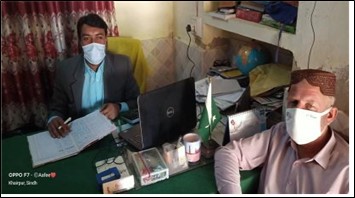 As shared earlier, parents and community members could not even afford masks for their children. To support this, we collected donations from teachers and a financially privileged villager for providing simple masks, made by the local tailor. We then distributed masks among all students of the school.
As shared earlier, parents and community members could not even afford masks for their children. To support this, we collected donations from teachers and a financially privileged villager for providing simple masks, made by the local tailor. We then distributed masks among all students of the school.
Through constant messaging, we made students aware about the importance of frequent hand washing during the pandemic. Students were asked to wash their hands frequently with soap properly to avoid contracting the virus. To facilitate frequent handwashing, the school management provided soaps at each of the hand pumps of the school.
Parents and the community were also actively engaged-with in multiple ways. Along with a door-to-door campaign, an initial meeting was organized with parents to make them aware about precautions related to COVID-19. Later, another meeting was engaged in with parents to keep them abreast of the initiatives to promote their children’s online learning. Such activities/initiatives included making subject and topic-wise videos for students with the help of teachers, which were then to be sent to parents through WhatsApp, Facebook etc. Moreover, parents were given awareness about tele-school so that their children could benefit from watching. A support/facilitation system was also put it into place in the form of having graduate students of the community, who were off from their respective universities due to the lockdown, volunteer to be guides for parents in how to access online resources in such ways as helping them use 4G mobile data.
Furthermore, a final meeting of parent teacher association (PTA) along with the school management committee (SMC) members was organized when the government allowed schools to partially reopen. The purpose was to share the shifts and timings for students and set a new timetable for the SMC with the help of parents. The following schedule was agreed upon unanimously:
Each grade was required to attend once a week. The following timetable was devised:
GBELS Muhammad Khan Shar, Taluka: Faiz Gunj, Khairpur
|
|
Grade |
Teaching days |
9th and 10th grades
|
Monday |
| 7th and 8th |
Tuesday |
| 5th and 6th |
Wednesday |
| 3rd and 4th |
Thursday
|
| 1st and 2nd |
Friday |
| Nursery & KG |
Saturday
|
On average, there were 80 students in each grade. The new timetable would ensure social distance was maintained, minimize the risk of COVID-19 transmission and maintain a manageable number of students in each classroom.
However, during this final meeting, most of the parents raised objections about a partial re-opening and demanded the resumption of the normal classroom setup.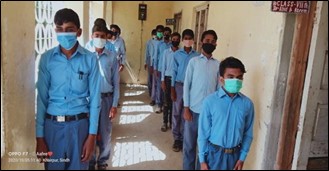
This was impossible due to the shortage of classrooms and ongoing construction work. [Most of the schools in rural areas lack basic facilities like availability of classrooms, washrooms and drinking water. The Sindh Government had utilized the closure time to conduct repairs for dilapidated schools].
Parents were very keen to send their children to school for a number of reasons. They were concerned because it had been an extended break of more than six months and naturally they were afraid of the impact this disruption would have on their children They also seemed to have realized the importance of teachers. This became apparent when they talked about their children’s activities at their homes. One of the parents of a naughty but proactive student said during the meeting, “I salute you teachers, how do you satisfy my son during teaching? I tried to teach him during the closure of school but he asked many questions." Their objections were also fueled by their lingering belief that coronavirus was not real.
After a long debate and discussion with the community, it was agreed to conduct two consecutive classes for each grade. As the majority of the parents did not have formal schooling, there were concerns about how parents would support their children. It was decided that parents would ask children about what was assigned to them. It was an apt example of collaboration between school leadership, teachers and parents.
Reflections on the Role of Head Teachers in Public Schools
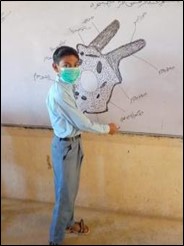 In the first week of the reopening, students attendance was 90 per cent and they had the complete support of parents. Parents were keen to see their children resume studies after the disruption caused by COVID-19.
In the first week of the reopening, students attendance was 90 per cent and they had the complete support of parents. Parents were keen to see their children resume studies after the disruption caused by COVID-19.
A head of the school is the leading character in the school with that role he/she can initiate any programme with engaging teachers, students, parents and community. With the help of discussing issues with parents and teachers you can have solutions according to the area. Normally it is easy to run an institute by looking after management of the school, including smooth teaching and learning process, students and teachers’ engagement.
This coordination between the school, teachers, parents and the community and the care that was taken seemed to pay dividends as no COVID-19 positive cases were reported in the school or surrounding areas even after the reopening of the school.
My major learning as a school leader, from this entire experience, was that it is vital to plan for unexpected incidents/ emergencies/crises so that the teaching and learning process may continue rather than become its hostage.

References
-
Khan, A. (2020, November 24).
COVID-19: students caught in Pakistan’s digital divide. Nature.
-
Dawn (2020, September 24).
Sindh to go ahead with reopening schools despite health minister's warning. Dawn.
-
Dawn (2020, November 25). Sindh government's stance on schools’ closure not taken into account, says Saeed Ghani. Dawn.
-
Mujahid, N., & Noman, N. (2015).
Infrastructure availability in the public sector schools: a case study of Sindh province. Journal of Education and Practice, 6(4), 60-67.
About the Author
Aftab Hussain Rajper is currently pursuing a MPhil in Education from AKU-IED and working as a Head Teacher at a government school in Tahsil Faiz Gunj in the Khairpur Mir district of Sindh. Aftab holds a LLB, Masters in English and Masters in Education from Shah Abdul Latif University, Khairpur.


